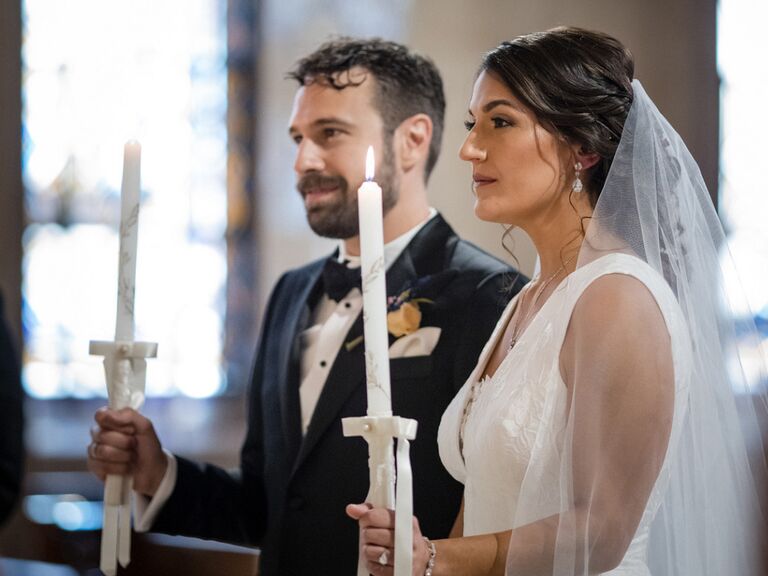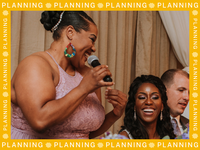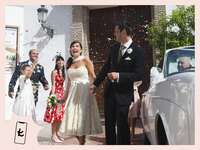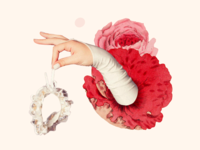Greek Orthodox Wedding Program Essentials

If you grew up in a Greek Orthodox household, then you may already be aware of Greek wedding traditions and the ceremonies involved during a Greek Orthodox wedding.
Many of the symbolic rituals included in a Greek Orthodox wedding service date back to the 11th century and are filled with beautiful meaning. Because of this, it may be helpful to include some of the key points of the ceremony in your wedding program to help guests who might be unfamiliar with this branch of the Christian faith understand what's happening.
While some elements of a Greek Orthodox wedding might be easier to understand in context, like scripture readings or the exchanging of rings, for example, some more unique traditions like the Common Cup or the Dance of Isaiah, or who the Koumbaros and Koumbara are might need a bit more explanation.
Below are some examples of what you may want to include in a Greek Orthodox wedding program, some samples of possible traditional wedding program wording, and information on where you can buy Greek Orthodox wedding programs ahead of the wedding day.
What To Include in a Greek Orthodox Wedding Program?
While some elements of a Greek Orthodox wedding ceremony may differ depending on the preference of the couple or based on geographical location (for instance, in Greece guests greet the bride outside and walk with her down the aisle, whereas in the United States they wait for the bride inside the church) there are certain key points that are universal.
Always include the following in your Greek Orthodox wedding ceremony program:
- Betrothal: The couple are betrothed in the name of The Holy Trinity, and the Koumbaros or Koumbara (wedding sponsors) will exchange the rings between the right-hand ring fingers of the bride and groom three times.
- Joining of Hands: The priest performs the sacrament of marriage and blesses the couple's future life together.
- Crowning: The bride and groom are crowned with Stefanas, two wedding crowns joined by a ribbon symbolizing their new oneness of mind and heart.
- Scripture Readings: The priest reads a passage about love and respect from the book of Ephesians, and also from the book of St. John where it describes the story of the wedding at Cana in Galilee.
- Common Cup: Both the bride and groom drink three times out of the same cup of wine.
- Dance of Isaiah: The priest leads the bride and groom on a ceremonial walk around the altar, accompanied by either the Koumbara or Koumbaros who holds the ribbon of the Stefana.
- Blessing: The priest blesses the married couple and concludes the wedding service by bringing the book of the Holy Gospel down through the couple's clasped hands, symbolizing only God may separate them. A kiss is not customary at a traditional Orthodox Christian wedding.
Greek Orthodox Wedding Program Wording Examples
While these are by no means exhaustive, here are some examples of the wording you might use in a Greek Orthodox wedding ceremony program.
- Betrothal: In a Greek Orthodox wedding, the exchange of rings is called the betrothal. The priest will bless the rings three times and announce that the couple is betrothed in the name of the Father, Son and the Holy Spirit. The rings are then placed on the right-hand ring fingers and are exchanged between the couple three times by either the Koumbaros or the Koumbara to symbolize the Holy Trinity and the joining together of the couple's two lives into one in holy matrimony.
- Joining of Hands: In the Greek Orthodox Church, marriage is one of the seven sacraments, along with baptism, Chrismation, Communion, holy orders, penance and the anointing of the sick. The bride and groom are each given tapered white candles called Lambethes that symbolize the couple's willingness to receive Christ. The priest will ask the couple to join hands and call upon God to unify both of them in mind and body. Prayers are said over the couple, asking for a long life filled with peace, happiness and health.
- Crowning: Next comes the crowning. The crowning is a highly symbolic ritual and is central to the Greek Orthodox marriage ceremony. Two crowns called Stefanas, joined by a ribbon, are placed on the couple's heads, naming them the king and queen of their home. Blessings are said over the couples as the Koumbara or Koumbara exchanges the crowns between the couple's heads three times.
Where to Buy Greek Orthodox Wedding Programs
When looking for a vendor for your wedding programs, our marketplace is filled with an extensive list of vetted vendors that are able to fully customize your order based on your needs. Browse vendors to assist you in creating your wedding program here. However, if you're looking for pre-designed ceremony programs that you can adjust to fit your needs, take a peek at our ceremony programs that you can order directly from your computer. No matter how you procure your wedding ceremony programs, make sure to bookmark this info to ensure you include all the pertinent details needed in your wedding-day programs.




















